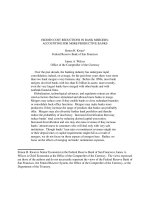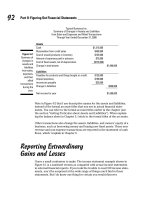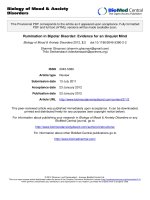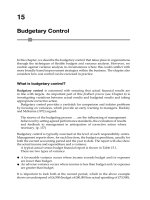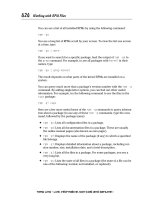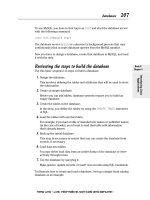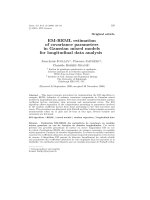HIDDEN COST REDUCTIONS IN BANK MERGERS: ACCOUNTING FOR MORE PRODUCTIVE BANKS docx
Bạn đang xem bản rút gọn của tài liệu. Xem và tải ngay bản đầy đủ của tài liệu tại đây (43.04 KB, 20 trang )
Simon H. Kwan is Senior Economist at the Federal Reserve Bank of San Francisco; James A.
Wilcox is Chief Economist at the Office of the Comptroller of the Currency. The views expressed
are those of the authors and do not necessarily represent the views of the Federal Reserve Bank of
San Francisco, the Federal Reserve System, the Office of the Comptroller of the Currency, or the
Department of the Treasury.
HIDDEN COST REDUCTIONS IN BANK MERGERS:
ACCOUNTING FOR MORE PRODUCTIVE BANKS
Simon H. Kwan*
Federal Reserve Bank of San Francisco
James A. Wilcox
Office of the Comptroller of the Currency
Over the past decade, the banking industry has undergone rapid
consolidation; indeed, on average, for the past three years there were more
than two bank mergers every business day. Before the 1990s, most bank
mergers involved banks with less than $1 billion in assets; more recently,
even the very largest banks have merged with other banks and with
nonbank financial firms.
Globalization, technological advances, and regulatory retreat are often
cited as factors that have stimulated and allowed more banks to merge.
Mergers may reduce costs if they enable banks to close redundant branches
or consolidate back-office functions. Mergers may make banks more
productive if they increase the range of products that banks can profitably
offer. Mergers may also diversify further bank portfolios and thereby
reduce the probability of insolvency. Increased diversification then may
reduce banks’ total costs by reducing desired capital-asset ratios.
Increased diversification and size may also raise revenues if they increase
banks’ attractiveness to customers who will deal only with very safe
institutions. Though banks’ loan rates or noninterest revenues might rise
or their deposit rates or capital requirements might fall as a result of
mergers, we do not focus on those aspects of mergers here. Rather, we
focus on the effects of merging on banks’ noninterest expenses.
2
One of the most striking aspects of the recent wave of bank mergers has
been the split between bankers and economists about the practical
importance of these advantages to merged banks on average. The
managements of merging banks and industry analysts often project sizeable
cost reductions, typically to be achieved by reducing labor and physical
capital inputs. Economists in universities and in bank regulatory agencies
have been hard pressed, however, to identify systematic, merger-related
gains in bank productivity.
The lack of consensus even extends to the issue of which mergers are
most likely to cut costs. Though there is some evidence from economists’
estimates of banks’ cost functions and post-merger performance studies
that mergers of the smallest banks might reduce costs, little evidence has
been found to support the claim that bank mega-mergers cut costs. One
bank-merger advisor noted to us that the banking industry’s ranking of the
ability to reduce costs following bank mergers was the reverse of
economists. His evaluation was that the industry regarded the
overwhelming majority of mergers between large banks (those with at least
$5 billion in assets) as cutting costs, the mergers of middle-sized banks as
having a mixed record on cost-cutting, and the overwhelming majority of
mergers of banks with less than $300 million of assets as having achieved
few, if any, cost reductions.
Our view is that the data conventionally used to study whether mergers
produce more efficient banks typically have underestimated a number of
sizeable and long-lasting cost reductions that merged banks have achieved.
A primary source of underestimates of cost reductions is found in the rules
of accounting for mergers. The bank mergers of the 1990s have often
triggered accounting adjustments that biased reported costs upward. The
rules of purchase-method merger accounting often result in upward
revaluations of the merged, or combined, banks’ assets. Mergers in recent
years have triggered increases in the accounting values of both physical and
intangible bank assets. As a result, post-merger banks reported higher
depreciation and amortization charges, even if they owned and operated
the same buildings and equipment after the merger as they did before the
merger. Below we identify the specific cost categories where this merger-
driven bias may be particularly large, long-lasting, and widespread.
3
I. Evidence on Post-Merger Cost Cutting
A. Statistical studies
Berger (1998) concurred with the results and views of many economists
that bank mergers generally had little effect on noninterest costs. Boyd and
Graham (1998) concluded that mergers of very small banks reduced costs.
Banks of this size often had well under $100 million in assets, which is
likely to mean that the sample consisted primarily of banks that had fewer
than three dozen employees.
It is often argued that the structure of technological advances has been
such that larger operations could reduce average costs because of the large
fixed-cost component in the “back-office” operations of banking, such as
payment processing. Hancock, Humphrey, and Wilcox (1998) estimated
that the Federal Reserve’s electronic payments transfer system, Fedwire,
exhibited increasing returns to scale. They reported that, indeed, the Fed
reduced its average costs with higher volume, even after adjusting its costs
for the ever-declining real costs of telecommunication and data-processing
equipment. This suggests one specific part of bank operations where larger
scale might reduce costs and thereby justify mergers.
Chamberlain (1998) reported that “other noninterest expenses” (ONIE)
rose, while expenses attributed to premises and other physical assets and to
labor declined following bank mergers. ONIE are the noninterest expenses
other than those attributable to labor, occupancy, and equipment expenses.
She concluded that on balance bank mergers did not lower banks costs.
Based on our hypothesis about the upward revaluation of intangible assets,
whose charges are included in ONIE, we would expect that mergers would
raise reported ONIE, quite apart from any economic changes in ONIE.
That same argument applies to the expenses for premises and other
physical assets. In her sample, the reductions in the economic values of
those expenses may have been overwhelmed by the accounting increases
triggered by the mergers.
4
B. Case studies
Linder and Crane (1992) compared the changes in performance
measures, such as operating income, of a group of banks that merged with
those of a group that did not merge. They found little difference between
the changes achieved by the two groups, which suggested that merging
alone did not improve performance. Rhoades (1998) reported on case
studies performed on nine recent bank mergers. These mergers were
deliberately chosen as being most likely to reduce costs: The mergers
involved large banks whose markets had substantial geographic overlap.
He concluded that only four of the mergers cut costs relative to those of
non-merging peer banks, even though all of the mergers produced cost cuts
in line with the banks’ projections. The largest cost reductions were
achieved by reducing the numbers of employees and by reducing
computing expenses. Often about half of the cost cuts were attributed to
reduced labor costs. Though more efficient banks tended to take over less
efficient banks in Rhoades’s sample, efficiency gains were not well
predicted by the absolute or relative efficiency of the dominant partner, nor
did other performance measures or size help systematically predict which
mergers would most cut costs.
C. Industry Analysis
Bender and Marks (1996) disputed whether bank mergers were likely to
raise profits by reducing costs. They analyzed mergers of very large banks
(Bank of America and Security Pacific, Chemical and Manufacturers
Hanover, etc.). They reasoned that though larger banks sometimes
operated more cost efficiently, reduced operational costs rarely translated
into higher profits because of increased loan losses and reduced ability to
serve the profitable small-business segment of the commercial loan market.
Bender and Marks (1996) also argued that technological advances may
well have reduced the scale required to minimize average technology costs:
Outsourcing possibilities and the advent of off-the-shelf hardware and
software made it feasible for smaller banks to deliver technology-related
services about as cheaply as larger banks did.
According to an article in the June 20, 1998 issue of the Economist,
Andersen Consulting calculated that smaller banks have been consistently
5
more cost-efficient in recent years than larger banks. Andersen calculated
that, since 1995, banks with less than $10 billion of assets had expenses
(including loan loss provisions and restructuring charges) per individual or
small business customer that were about 20 percent lower than those at
larger banks. Profits per customer were also lower at larger banks.
D. Summing Up
Pilloff and Santomero (1998) surveyed both the statistical and case
study literature on bank mergers. Based on their reading of the enormous
empirical literature on bank costs, they concluded that on average the
market valued the combined firm no higher than it did the separate
components. Had merging cut costs, higher total market value would have
been anticipated. Furthermore, on average, no empirical studies have
reported performance gains after merging. Thus, the academic literature
provides little evidence that banks reduced costs by merging. Analysis by
industry analysts also suggests skepticism about the cost-reducing benefits
of mergers.
II. Data
Our merger sample is obtained from the merger file at the Federal
Reserve Bank of Chicago, which contains 8032 bank mergers between
1985 and 1997. We select bank mergers from the merger file using the
following sampling criteria: (i) both of the merged banks must be healthy
institutions at the time of the merger; (ii) both merged banks did not
engage in another merger two years before or after the merger date; (iii)
both institutions must be in operation for at least two years prior to the
merger and must have total assets greater than $10 million during the
merger quarter; (iv) the accounting method (pooling of interest versus
purchase accounting) for the merger transaction must be known and can be
verified from the Wharton Research Data Service; and (v) the merger must
occur before 1996.
The first criterion eliminates all failed-bank mergers and government-
assisted bank mergers. The second filter allows us to compare the two-
year pre- and post-merger performance without the contamination of
another merger. The third criterion ensures the availability of banking data
6
for at least two years before the merger date, and eliminates the smallest
institutions from the sample. The accounting method criterion is necessary
for the adjustment of reported cost data that is the key to this study.
Finally, we exclude the most recent mergers that do not have at least three
years of reported data after the merger date.
1
These sampling criteria yield
a sample of 1154 bank mergers. Out of this sample, banks in 20 mergers
reported expenses that are either negative or unrealistically large.
2
Eliminating these outliers produces a final sample of 1134 bank mergers.
The benchmark for measuring the performance of merged banks is a
control sample of banks that did not engage in any mergers between 1985
and 1997. Like the merger sample, we also eliminate from the control
sample for each quarter banks with total assets less than $10 million, banks
that are less than two years old, and banks that report negative or
unrealistically large expenses. The number of banks in the control sample
varies during the sampling period. For example, we have a total of 5475
banks in the control group in 1987 Q1. In each quarter, all banks in the
control sample are grouped into four size categories: (i) small banks with
total assets between $10 million and $100 million, (ii) medium banks with
total assets between $100 million and $1 billion, (iii) large banks with total
assets between $1 billion and $10 billion, and (iv) mega banks with total
assets in excess of $10 billion.
For each bank in the merger sample or the control sample, we obtain
financial statements that are reported quarterly to the FDIC in the Call
Report. From the income statement, we obtain the following noninterest
expense data: salaries and costs of employee benefits, expenses on premises
and fixed assets, and other noninterest expenses.
3
Within the class of other
noninterest expense, we also obtain the information on the amortization
expense for intangible assets. From the balance sheet, we obtain the dollar
value of the following quarter-end data: premises and fixed assets,
intangible assets, and total assets.
III. Methodology
To measure the post-merger change in bank operating performance, we
compare the post-merger performance of the merged bank relative to its
7
[X
Ai
- X
PEER
A
]-[X
Bi
- X
PEER
B
]
control group of similar sized banks with the pre-merger performance of
the merged banks relative to the peer group. Thus, we define Change in
Relative Operating Costs (CROC) for the ith bank merger as:
where subscript A stands for after-merger and subscript B stands for
before-merger. The four performance variables to be analyzed are: (i) ratio
of total noninterest expenses to total assets (NIE), (ii) ratio of labor
expenses to total assets (LAB), (iii) ratio of premises expenses to total
assets (PREM), and (iv) ratio of other noninterest expenses to total assets
(ONIE).
We compare each merger with one of the four size-based peer groups
according to the combined quarter-end total assets of the acquirer and the
target in the quarter immediately before the merger date, based on the same
size cutoffs for the control group. The absolute performances of each peer
group (X
PEER
) are the averages across all banks in the group of the eight-
quarter mean of the performance variable before and after the merger. For
the merged bank and its predecessor banks, the absolute performance
measures (X
i
) are the eight-quarter mean of the performance variable
before and after the merger quarter.
4
Subtracting the absolute performance
of the peer group from that of the merged bank produces the relative
performance of the merged bank before and after the merger. Subtracting
the relative performance of the merged bank before the merger from its
relative performance after the merger yields the Change in Relative
Operating Costs. A negative CROC indicates cost savings were achieved
after the merger.
IV. Accounting Issues
Currently, according to Generally Accepted Accounting Principles
(GAAP), there are two methods to account for business combinations:
purchase accounting versus pooling-of-interests. In purchase accounting,
all the assets of the target bank have to be marked to market before they
are combined with the acquiring bank’s assets, including the target bank’s
premises and equipment. The difference between the purchase price and
8
the revised book value of target bank’s equity, after marking all target
bank’s assets to market, will be recorded as goodwill, an intangible asset, in
the surviving bank’s book. All intangible assets must be amortized and
expensed per GAAP. Hence, in purchase accounting mergers, both the
stock of bank premises and the stock of intangible assets for the surviving
bank would likely be higher than those of the combined total of the
acquirer and target before the merger due to purchase accounting alone.
If the recorded bank premises and intangible assets are marked up due
to the use of purchase accounting, the surviving bank’s depreciation charge
and amortization expense will rise instantly, even if the surviving bank
changes nothing after the merger.
In pooling-of-interests, the target bank’s assets, liabilities, and owner’s
equities are combined with those of the acquiring bank at book value as
though the two companies had always been commonly owned. Thus, the
reported assets of the merged bank would be equal to the sum of the
reported assets of the two merging banks, absent any real changes in bank
assets after the merger. Hence, unlike purchase accounting, pooling-of-
interests would not trigger additional depreciation expenses or goodwill
charges. However, the merging banks must satisfy all the conditions for
pooling, including certain pre-merger attributes such as comparable sizes,
and post-merger activities limiting assets sales or stock repurchase;
otherwise, the purchase accounting method must be used.
Figure 1 shows that in our merger sample, about one-third of the
mergers used purchase accounting method to account for the merger
transaction, and the percentage of purchase accounting mergers also was
rising during our sampling period. Figure 2 shows that the average ratio of
market value to book value equity for banking companies was also rising.
As a result, the purchase accounting effect on reported expenses is likely to
be larger during the latter part of the sampling period than during the
earlier part.
To obtain a more accurate measure of the change in genuine operating
performance of a merged bank that uses the purchase accounting method,
we adjust the merged bank’s reported premises expenses and other
noninterest expenses by the amount that is attributable to the purchase
accounting revaluations. Specifically, denote the quarter when the merger
is consummated as quarter 0 and the quarters immediately before and after
as quarters -1 and +1, respectively. We first compare the reported fixed
9
premises of the merged bank in quarter 0 to the combined total fixed
premises of the two constituent banks in quarter -1.
5
If the reported fixed
premises go up after the merger, we assume that this is due to the
revaluation of the target bank’s premises. We then attribute the
difference between the reported quarter +1 and quarter -1 premises
expenses as the incremental premises expense attributable to purchase
accounting, denoted as XP. XP is then subtracted from the reported
premises expense for all post-merger quarters in calculating the adjusted
premises expenses (PREMXP). We perform the same adjustment on
reported intangible assets between quarter 0 and quarter -1. Assuming the
difference between quarter +1 and quarter -1 amortization expenses as the
incremental amortization expense triggered by purchase accounting,
denoted as XG, the adjusted noninterest expense (ONIEXG) is calculated
by subtracting XG from ONIE for all post-merger quarters. Finally, we
adjust total noninterest expense by subtracting both XP and XG from NIE,
denoted as NIEXPXG.
V. Findings
Table 1 presents the average change in relative operating costs for 1134
bank mergers between 1987 and 1995. In the first panel, the average
change in total noninterest expense of merged banks was -0.003. Although
the negative sign indicates that on average, banks cut total noninterest
expenses after the merger, the cut was not statistically significantly
different from zero. Of the three operating cost components, labor costs
registered the largest drop after the merger, falling an average annual
amount of 0.02 percent of total assets. Unadjusted premises expenses,
however, on average went up by 0.009 percent of total assets after the
merger, and the increase is significant at the 5 percent level. While
unadjusted other noninterest expense also rose after mergers, the increase
is not statistically significant.
As shown in the middle panel of Table 1, purchase accounting triggered
significant incremental premises expenses (XP) and incremental intangible
expenses (XG). Additional premises expenses, XP, averaged 0.016 percent
of total assets, and additional intangible expenses, XG, averaged 0.022
percent of total assets. In the bottom panel, adjusting premises expenses
by XP yields a significantly negative change in PREMXP, indicating that
10
merged banks on average did cut occupancy costs; occupancy expenses
declined by 0.008 percent of total assets after merging. After adjusting for
the incremental amortization expense, changes in ONIEXG becomes
negative, but it is not significant. Regarding total noninterest expense, the
adjusted NIE, NIEXPXG, on average fell by a significant 0.042 percent of
total assets after the merger. This suggests that bank mergers do result in
operating cost savings. For a merged bank that earns say, 1 percent return
on assets (ROA), the average cost savings reported in Table 1 translate
into a 4 percent increase in ROA.
In Table 2, we repeat the analysis after dividing the merger sample into
three time periods: 1987-89, 1990-92, and 1993-95. We find that even
without the purchase accounting adjustments, total noninterest expense fell
by 0.049 percent of total assets after the merger in the 1993-95 subperiod,
and the cost saving is statistically significant. Of the three operating cost
components, labor cost showed the largest cut in the 1993-95 subperiod,
whereas unadjusted premises expense showed a significant rise after the
merger in this time period.
The adjustment for premises expense is significantly positive in all three
subperiods. The adjustment for amortization expense rose over time, and
is significantly positive during the two most recent subperiods. This
reflects the fact that purchase premia over the book values of target banks
were rising over time, as the market value of banking companies were
rising in general.
Adjusting the premises expense by the XP turns the positive changes in
PREM to negative changes in PREMXP after the merger, but none of the
changes in PREMXP in the three subperiods are significant. On the other
hand, changes in adjusted ONIE, ONIEXG, is found to be significantly
negative in the last two subperiods, indicating that merger related cuts in
other noninterest expense on average exceed labor cost savings. On net,
mergers in 1993-95 shaved adjusted total noninterest expense, NIEXPXG,
by a statistically significant 0.1 percent of total assets, which is equivalent
to a 10 percent boost in a 100 basis points ROA. Change in NIEXPXG is
insignificant for the two earlier time periods.
Table 2 clearly suggests that recent bank mergers seem to cut operating
costs more than earlier bank mergers. To test this hypothesis formally, we
compare the cost cuts for mergers in 1993-95 to those that occurred in
1987-92. In Table 3, we regress each performance measure against a
11
dummy variable for 1993-95 mergers and an intercept term. The
coefficient on the dummy is found to be significantly negative for the
NIEXPXG regression, confirming that the cost savings for mergers in
1993-95 were significantly larger than those in earlier time periods. The
1993-95 mergers dummy is also significantly negative for the unadjusted
NIE regression, as well as for the ONIEXG regression.
Finally, to test whether mergers involving large banks cut costs more
than mergers among smaller banks, we regress each performance measure
against a dummy variable for large merger and an intercept term separately
for the three time periods. The dummy variable for large merger equals
one if the total assets of the merged bank at the time of the merger exceeds
$1 billion, and equals zero otherwise. Table 4 shows that on balance, cost
savings in large bank mergers did not differ significantly from smaller bank
mergers. In the NIEXPXG regressions, while the coefficient of the large
merger dummy is positive in the two earlier subperiods, it becomes
negative in 1993-95, providing some weak evidence that the operating
performance of large mergers, relative to their smaller counterparts,
seemed to be improving over time.
VI. Conclusions
In this study, we revisit an important question in banking: Do bank
mergers lead to operating cost savings? While the majority of past
research did not find significant cost reduction after banks merged, bank
managers and banking consultants cite improving operating cost efficiency
as a primary motivation for bank mergers. This is probably one of the
starkest discrepancies between banking researchers and practitioners.
In this study, we recognize an important measurement issue in using
reported financial data to compare pre- and post-merger operating
performance. In mergers where the purchase accounting method is used to
account for the business combination, all the assets of the target institution
have to be marked to market before being combined with the acquirer’s
book assets, and the difference between the purchase price and the revised
book value of target bank’s equity is recorded as goodwill in the surviving
bank’s book. These additional assets must be expensed according to the
amortization schedule under GAAP.
12
The purchase accounting method therefore can trigger additional
occupancy expense and amortization expense by the surviving bank that
have nothing to do with actual costs. Hence, to measure performance
change before and after the merger more accurately, this study adjusts the
reported data to eliminate the pure accounting effects on reported costs. In
addition, we also include more recent data in our analysis so that we cover
a period when the banking industry is financially much stronger and the
pace of banking consolidation is rapid.
We find evidence that bank mergers reduced operating costs. Both
labor cost and occupancy expense are found to decline significantly after
the merger. The cost reductions during the full sampling period are evident
only after we remove the pure accounting effects on reported expense data,
confirming that merger accounting can hide a significant portion of cost
cuts. Nonetheless, our subperiod analysis suggests that only more recent
bank mergers were able to achieve significant cost cuts, with the
accounting bias hiding one-half of the cost reduction. Earlier mergers did
not seem to produce cost savings, despite the removal of the accounting
bias. We also find that the size of the merging institutions does not have
significant effects on the amount of cost savings.
Endnotes
1. For robustness, we also conduct three-year pre- and post-merger
performance comparisons. They produce qualitatively similar results.
2. We consider annualized labor costs in excess of 5 percent of total
assets, annualized premises expenses in excess of 5 percent of total assets,
or annualized other non-interest expenses in excess of 10 percent of total
assets to be outliers.
3. Other noninterest expense includes 34 categories of expense items. For
example, it includes fees paid to directors for attending board meetings,
Federal Deposit Insurance assessments, legal fees, amortization expense of
intangible assets, costs of data processing, and advertising and promotional
expenses.
13
4. Note that data for the merger quarter are omitted from the analysis. In
the cases where the purchase accounting method was used for the merger
transaction, the merged bank reported the expenses equal to the acquirer’s
full quarter of expenses plus the expenses incurred by the target from the
merger consummation date through the end of the quarter. This makes the
reported quarterly expenses of the merged bank for the merger quarter
inconsistent with the pre- and post-merger quarterly expenses.
5. The balance sheet variables for the merged bank reported for the merger
quarter are stock variables as of the end of the quarter and are free of the
“flow” problem noted in endnote 4.
References
Bender, Arthur K., and James M. Marks. “Bank Merger Mythology: Why
Bank Mergers Do Not Benefit Acquiring Shareholders,” Sutro & Co.
Special Report, March 25, 1996.
Berger, Allen N. “The Efficiency Effects of Bank Mergers and
Acquisition: A Preliminary Look at the 1990s Data.” In Bank Mergers &
Acquisitions, edited by Yakov Amihud and Geoffrey Miller, Kluwer
Academic Publishers, 1998.
Boyd, John H., and Stanley L. Graham. “Consolidation in U.S. Banking:
Implications for Efficiency and Risk.” In Bank Mergers & Acquisitions,
edited by Yakov Amihud and Geoffrey Miller, Kluwer Academic
Publishers, 1998.
Chamberlain, Sandra L. “The Effect of Bank Ownership Changes on
Subsidiary-Level Earnings.” In Bank Mergers & Acquisitions, edited by
Yakov Amihud and Geoffrey Miller , Kluwer Academic Publishers, 1998.
Hancock, Diana, David B. Humphrey, and James A. Wilcox. “Cost
Reductions in Electronic Payments: The Roles of Consolidation,
14
Economies of Scale, and Technical Change,” Journal of Banking and
Finance, Forthcoming 1998.
Linder, Jane C., and Crane, Dwight B. “Bank Mergers: Integration and
Profitability,” Journal of Financial Services Research 7 (1992), 35-55.
Pilloff, Steven J., and Anthony M. Santomero. “The Value Effects of Bank
Mergers and Acquisitions.” In Bank Mergers & Acquisitions, edited by
Yakov Amihud and Geoffrey Miller , Kluwer Academic Publishers, 1998.
Rhoades, Stephen A. “The Efficiency Effects of Bank Mergers: An
Overview of Case Studies of Nine Mergers,” Journal of Banking &
Finance 22 (1998), 273-291.
15
TABLE 1
Do Mergers Cut Costs?
Change in 8-quarter mean relative operating costs
1134 mergers between 1987 and 1995
(percent of total assets)
NIE -0.003
LAB -0.020*
PREM 0.009*
ONIE 0.008
Adjustments:
XP 0.016*
XG 0.022*
Adjusted Expenses:
PREMXP -0.008*
ONIEXG -0.014
NIEXPXG -0.042*
*: Significant at the 5% level.
16
TABLE 2
Do Recent Mergers Cut Costs More?
Change in 8-quarter mean relative operating cost
1134 mergers between 1987 and 1995
(percent of total assets)
1987-89 1990-92 1993-95
NIE 0.045 -0.005 -0.049*
LAB -0.014 -0.009 -0.037*
PREM 0.006 0.009 0.011*
ONIE 0.053* -0.006 -0.023
Adjustments:
XP 0.015* 0.018* 0.016*
XG 0.009 0.022* 0.036*
Adjusted Expenses:
PREMXP -0.01 -0.009 -0.005
ONIEXG 0.045* -0.027* -0.058*
NIEXPXG 0.021 -0.045 -0.100*
*: Significant at the 5% level.
17
TABLE 3
Was 1993-95 Significantly Different?
1134 mergers between 1987 and 1995
(percent of total assets)
Dummy Variable
for 1993-95 t-statistic
NIE -0.068* -2.37
LAB -0.026 -1.76
PREM 0.004 -0.54
ONIE -0.046* -2.26
Adjustments:
XP -0.001 -0.27
XG 0.021* -3.41
Adjusted Expenses:
PREMXP 0.004 -0.63
ONIEXG -0.066* -3.27
NIEXPXG -0.087* -3.05
*: Significant at the 5% level.
18
TABLE 4
Do Large Mergers Cut Costs More?
Coefficients on dummy variable for large mergers
1134 mergers between 1987 and 1995
(percent of total assets)
1987-89 1990-92 1993-95
NIE 0.02 0.094 -0.073
LAB 0.031 -0.032 -0.084
PREM 0.035 -0.052* -0.003
ONIE -0.047 0.178* 0.014
Adjustments:
XP -0.022* -0.013 -0.015
XG 0.003 0.002 -0.003
Adjusted Expenses:
PREMXP 0.058* -0.039* 0.012
ONIEXG -0.05 0.175* 0.012
NIEXPXG 0.039 0.104 -0.06
*: Significant at the 5% level.
19
Figure 1: Percentage of Bank Mergers Using Purchase
Accounting
0
5
10
15
20
25
30
35
40
45
50
1987 1988 1989 1990 1991 1992 1993 1994 1995
0
50
100
150
200
250
300
percent
year
percent purchase
number of mergers
number
20
Figure 2: Average Price-to-Book Ratio
0.6
0.8
1
1.2
1.4
1.6
1.8
1987 1988 1989 1990 1991 1992 1993 1994 1995
Price-to-Book
year


